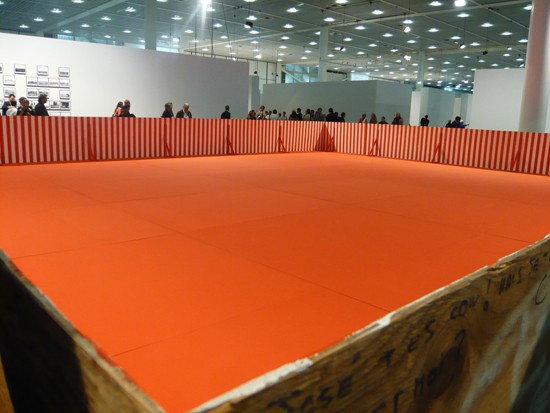
Daniel Buren – Installation view of Autour du retour d’un détour (1988) in Art Unlimited at the 42nd edition of the Art Basel art fair, 2011. Photo ART iT.
The international art fair Art Basel launched its 42nd edition Jun 14 in Basel, Switzerland, with a preview for VIP collectors. Usually timed to coincide with the Venice Biennale, the fair this year has broken with form in opening almost a week after the Venice press preview. Despite concerns the late start would affect the number of visitors to Basel, many collectors and dealers told ART iT they had prioritized visiting the fair over the biennale.
Although the intensity of transactions at this year’s preview still did not match that of the height of the recent art market boom, sales were still strong, with works by young and mid-career artists like Danh Vo (Isabella Bortolozzi, Berlin) and Friedrich Kunath (BQ, Berlin) doing well. Indeed, much of the attention at the preview seemed to be directed at the Art Statements section for solo shows by young artists. In addition to Venice Biennale participant Emily Wardill (Jonathan Viner Gallery, London), other standouts here included Petrit Halilaj (Chert, Berlin), Alex Hubbard (Maccarone, New York) and Kaari Upson (Overduin & Kite, Los Angeles). Included from Japan, Tokyo’s Gallery Side 2 featured an arrangement of paintings and floor-based objects by Yuko Murata.
On the other hand, whereas it had previously been known as a showcase for large-scale new commissions, the Art Unlimited section this year was notable for its retrospective atmosphere, with numerous works from the 1980s and ’90s by established artists such as Mario Merz, Dan Flavin, Fred Sandback and Jason Rhodes. Most impressive was Galleria Continua’s (San Gimignano) presentation of Daniel Buren’s Autour du retour d’un détour (1988), a brilliant orange-carpeted platform squared off by a chest-high barrier made of wooden panels. From 1985 to ’86, Buren had worked on a public art commission for the Palais-Royal in Paris. Entitled Deux Plateaux, the commission became the subject of heated debate over the placement of contemporary art at sites of historical significance, with numerous vandals scribbling oppositional statements and profanities on the wooden barrier surrounding the work during its production. Buren saved the enclosure, and turned it into the work that is now on display in Basel, with the graffiti sides of the panels facing the viewer, and the interior sides coated in a red-and-white stripe pattern.
Made for a solo exhibition at the Magasin national contemporary art center in Grenoble, the Buren piece was not only visually arresting, it was also emblematic of the current retooling of the machinery of international contemporary art. Intentionally made with common materials in order to emphasize their site-specifity and undermine their salability, works representative of movements like Arte Povera and Conceptual Art have now been completely integrated into the capitalistic art market. With large-scale installations regularly appearing at fairs attended by patrons who hold the strings to institutional purses, there is a rising tendency toward major collection purchases happening in such contexts, and a corresponding reevaluation of the idea of the research-driven institutional collection. Art Basel has been at the fore of spearheading this trend, and with its recent acquisition of a majority stake in the Art HK art fair, the multinational fair producer likely has no competition in its search to extend its grip over a market that continues to expand in both scope and influence.
